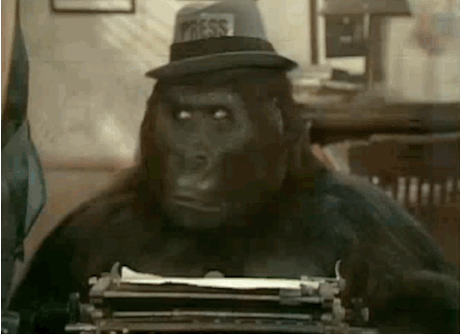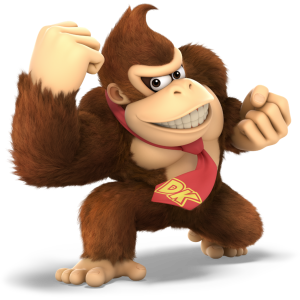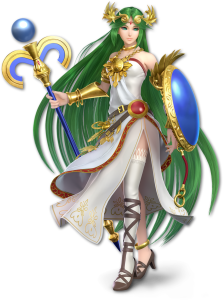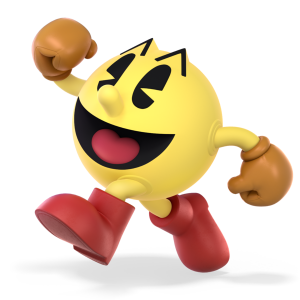
Featured in this post:



We have finally reached the penultimate entry in the Super Smash Bros. project. Are you ready to go ape?

2 – Donkey Kong
The western gorilla was originally described in 1847, and the species very quickly ingrained itself in public consciousness—gorillas could be seen as a wild counterpart to humanity, a mirror image through which we could project our foibles and fears. One of the most influential pieces of art depicting gorillas turned out to be French sculptor Emmanuel Frémiet’s 1887 piece “Gorille enlevant une Femme” (Gorilla Carrying Off a Woman), which despite its high culture origins would become the defining pop cultural image of the gorilla for almost a century.
King Kong was released in 1933, a landmark achievement in American film in terms of special effects, and a plotline that anyone you ask could recount with (relative) ease. Continuing the themes of Frémiet’s sculpture, Kong (the name created by director/producer Merian C. Cooper) amped up the size of the beast and then moved it to the big city, a further contrast to the man/nature question all apes seemed to pose. It also popularized the imagery of a gorilla carrying off a pretty lady and climbing things, which now included large buildings, and that particular conception of the gorilla would reverberate long after, in pretty much every medium possible—more importantly, though, it also made the ape at least a little bit sympathetic.
King Kong was, as one would guess, highly influential on special effects movies, and its influence spread worldwide, including Japan (where it was popular enough that “king kong” simply became a generic name for any gorilla)—there was even a long lost rip-off film called King Kong Appears in Edo made in 1938. Eiji Tsuburaya, SFX mastermind of Godzilla and many other movies and television shows, decided to get into moviemaking after seeing it. He would eventually get a chance to make two movies featuring Kong himself: King Kong vs. Godzilla in 1962 and King Kong Escapes in 1967 (the latter movie features Kong battling a mechanical duplicate, whose design I to this day believe served as a major inspiration for Rare’s eventual redesign of Donkey Kong.)
When they were initially unable to secure the rights to make an arcade game based on Popeye, Nintendo and Shigeru Miyamoto settled on making a game with a similar love triangle dynamic—and what visual motif could fulfill that dynamic better than King Kong‘s? You have the setting of a city construction site, a blue-collar character who would eventually be named Mario, a love interest named Pauline who would appear and disappear in subsequent games (although now she appears to be fully integrated into the Mario universe thanks to Mario Odyssey), and finally a big (but not so big) ape named Donkey Kong (because Donkeys are stubborn, you see), who while antagonistic, was also a goofy, likeable cartoon character, and endeared himself to players. Players liked him so much that Nintendo would bring him back in varying roles over the course of the decade. The game itself would become one of the most important in the history of Nintendo, and of the medium of video games entirely. It would also inspire a lawsuit from Universal Studios, who claimed that Donkey Kong infringed on King Kong—they would lose that lawsuit, mainly because Nintendo showed how Universal successfully argued the public domain status of King Kong in a lawsuit against the original film’s owners several years earlier.
While games featuring Donkey Kong had been made after 1981, he never actually had an active role as a playable character—it didn’t seem to fit his style. But by the nineties, it probably seemed strange to Nintendo that one of their biggest characters never truly “starred” in anything. After releasing one final game in his old style on Game Boy, Nintendo let Rare completely reinvent Donkey Kong and his world—he was no longer an animal in man’s world, but now an animal in his own natural environment, with his own goals and supporting cast. This more “naturalistic” depiction of a gorilla actually matched the ecologically-aware tone of the modern age, when our understanding of gorillas and other apes was much greater, and they became a symbol of a beautiful world that humanity should preserve—which made sense, as they are among our closest evolutionary relatives. The image of the gorilla relocated to the big city kidnapping women was history, and the new Donkey Kong reflected that—he was all about cruising jungles, hording bananas, and hanging out with other animals, all without a human in sight.
Even with a new set of traditions, Donkey Kong still retains a lot of his historical significance, both in what he means to Nintendo and where his inspiration came from. He manages to do this even when there have been long gaps between games he headlines, because he’s just that important. Donkey Kong will forever remain…the gorilla in the room. Sorry.

54 – Palutena
Much like in The Legend of Zelda, we have a character whose name is in the (Japanese) title of the game, but who served as little more than motivation. How does a goddess become a damsel in distress? You’d think possessing divine powers would prevent such things from happening—unless Palutena is meant to be equivalent to Persephone, who is taken to the underworld by Hades, but that myth at least has some metaphorical value (plus, Palutena is referred to as the “goddess of light”, which would really make her closer to Apollo, while also having traits similar to Athena.) The story of the original Kid Icarus is mostly a metaphor for how video games only had two plots in the eighties.
When Pit appeared in Super Smash Bros. Brawl, Palutena more or less retained her supporting role from the original game, appearing in a single cutscene and as a background image during Pit’s Final Smash (Pit is actually the only character who has had three completely different Final Smashes over the course of three games.) Still, they gave her a redesign much like they did for Pit, and when Masahiro Sakurai worked on Kid Icarus: Uprising, he decided to rejigger her personality as well—mainly, by giving her one. In Uprising, she feels more like an actual goddess: not only do we get the idea that people actually, you know, worship her and all that (and how the conflict between gods affects normal people is brought up as well), but also her divine powers are part of the story and game structure (Pit can only fly because of her powers, and she supplies him with the special abilities that she would end up using in Smash Bros.—and these facts are actually utilized in the plot itself.) She also ends up being a very funny character due to her relationship with Pit, who she does care for, but is still more than happy to treat as a minion/test subject who can be thrown against things just to see what happens. That cruelty streak is blunted somewhat by her regular acknowledgement that they’re all video game characters—these are fictional immortals who know that they’re immortal because they’re fiction.
Palutena still served as a supporting character in Uprising, but one that was much more directly involved, a constant presence much like the rest of the team in Star Fox—you get to hear from her a lot, and in this case, the fact that she can tell you about every facet of every enemy and item and what have you makes sense, because she’s a deity. Considering how perfunctory her role was in the first Kid Icarus, the changes made to her in the reboot are not just an improvement, but a very intelligent one—they began with very little, but had a firm understanding of the world of wacky Greek myths these characters inhabited, and could extrapolate from there. Palutena actually feels like a classical Greek goddess—lording over the world below, often guiding things without getting directly involved herself, getting into celestial struggles with other gods—but more importantly than that, she’s an entertaining one.

55 – Pac-Man
What is there to say about Pac-Man? He’s Pac-Man! Probably the first big video game character (as much as I like the Space Invaders, they weren’t quite characters yet), who got novelty records and bad Hanna-Barbera cartoons, and one who became popular while being as minimal as possible. But those colours! Those sounds! His basic but primal and urgent goal to eat everything without getting caught! These are the kinds of things that only video games can do: make us identify with a yellow circle because we ARE the yellow circle; games allow us to become anything because as soon as we are in control, we feel attached to our avatar, no matter what it is. As the second-oldest character featured in Smash Bros. (after Mr. Game & Watch), Pac-Man represents this bedrock aspect of game design, and by keeping his appearance as close to the original arcade cabinet art as possible (rather than integrating anything from the dozen or more redesigns he’s had over the years), he definitely feels like he brings his era into the series intact.
Sakurai mentions in one of his columns that if Pac-Man publishers Bandai-Namco—who also developed both the 3DS/Wii U games and Ultimate—didn’t allow him to use the original Pac-Man design, he was seriously considering not using Pac-Man at all. That’s commitment to a vision: aside from personal preferences, Pac-Man’s purpose as part of the Smash Bros. should be, as I said, to capture his point in time, the games of early eighties arcades. That’s the reason why Pac-Man looks just like he did in the old art, why he can transform into a 3D approximation of his original sprite, and why his taunts include references to other Namco arcade games like Mappy and Xevious (and some truly obscure ones, like King & Balloon)—Smash Bros. isn’t just including well-known characters for the sake of it, it’s actually trying to be historically-minded. To make it feel like a true gathering of multiple generations of characters, they have to carry some visual or design elements over from their first appearances—this isn’t just behind the design of Pac-Man, either, but in characters like Mega Man, Ryu, Sonic, Duck Hunt, Cloud, and even Mario. While some characters are a bit more open to interpretation, what makes a character like Pac-Man work so well in Smash Bros. is by organically integrating those original elements into a cohesive fighting style—Pac-Man doesn’t just look like Pac-Man, but he feels like Pac-Man as well.
More than including direct references, more than showing absolute fealty to the source material, the most important thing Smash Bros. can do when adapting a character is to capture the spirit of the character or game, or show it in a new light. This requires much deeper thinking than simply copying things from another game, including a real understanding of what those older games were trying to accomplish. As the series grew to become even more all-encompassing in where it pulled from video game history, this became even more important—getting that spirit becomes the major reason to include a character in the fist place. It becomes bigger than just a mash-up of character names and traits, but a feeling that all these different design philosophies can exist together in one space. With Pac-Man, you can add in one of the oldest conceptions of video games, his place in history full intact.